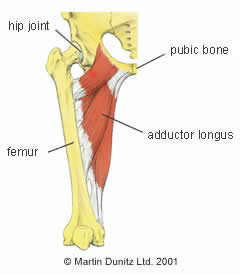Hip Labrum Tear in Depth
AKA: Acetabular Labrum Tear
| Common Signs & Symptoms | |||||
| Pain | Swelling | Stiffness | Weakness | Instability | Locking |
Hip Labrum Tear Injury Explained
 In recent years, advances in the medical knowledge of hip injuries have highlighted the problem of a torn Acetabular Labrum. This owes much to the pioneering work of Cambridge based orthopaedic surgeon Richard Villar. In the past, it had been said that “the hip was impossible to arthroscope”, because of its anatomical structure, but this only served to stiffen Villar’s resolve to prove this statement wrong. By developing specially adapted surgical equipment and devising a totally new surgical procedure, Villar carried out the first hip arthroscopy in the late 1980’s.
In recent years, advances in the medical knowledge of hip injuries have highlighted the problem of a torn Acetabular Labrum. This owes much to the pioneering work of Cambridge based orthopaedic surgeon Richard Villar. In the past, it had been said that “the hip was impossible to arthroscope”, because of its anatomical structure, but this only served to stiffen Villar’s resolve to prove this statement wrong. By developing specially adapted surgical equipment and devising a totally new surgical procedure, Villar carried out the first hip arthroscopy in the late 1980’s.
By visualising the hip joint using an arthroscope, orthopaedic surgeons have been able to document hip injuries in much more detail. Research has noted the incidence of a torn Acetabular Labrum is much higher than previously thought. For instance, there is no recorded research that even mentions this injury in soccer until the late 1990’s. In the past, these injuries would have gone undiagnosed but now the diagnosis can be confirmed and, in many cases, repaired arthroscopically.
Hip Labrum Tear Signs & Symptoms
A history of twisting on a weight bearing hip during sport is common. The onset of pain is immediate and is usually located at the front of the hip joint. As with all hip problems, the pain may become diffuse and difficult to pinpoint. It is not possible to see swelling, although the inflamed joint may become larger in volume because of an ‘effusion’ due to trauma. If the front of the hip joint is affected there may be a pinching sensation when the person flexes the hip by bringing the knee up to the chest. The pain may be reproduced in sport during activities that require weight bearing and twisting – i.e. kicking a football.
A Labral injury may also be brought on by repeated overuse of the Hip joint such as in running or cycling where repeated hip flexion and extension can inflame and dmage the Labrum.
It may be possible to see the injury using a CT or MRI arthrogram. These scans are done after a contrast medium has been injected into the joint to highlight the damaged Labrum. The injury is not always visible on a straightforward MRI scan or CT scan.
Hip Labrum Tear Treatment
What you can do
| Consult a sports injury expert | |
| Use a buoyancy belt for mobilisation exercises in a swimming pool | |
| Use resistance bands for muscle strengthening exercises | |
| Wear Compression Shorts for reassurance following surgery |
Help is now at hand with more and more surgeons learning the arthroscopic technique for the hip, a procedure that can be performed on an outpatient basis. Although a general anaesthetic is used, a stay in hospital is not usually necessary. A tear in the Labrum can be seen and trimmed using the arthroscope, with the whole procedure taking less than an hour.
Following surgery, the patient will be taught how to use crutches by a Chartered Physiotherapist and will remain on these for four or five days. This is purely precautionary because of the load bearing nature of the hip joint. Rehabilitation is continued under the supervision of a physiotherapist. Once the ‘portals’ where the arthroscope is inserted have healed, the patient can begin mobilising the hip joint to regain full range of movement. Exercises in a hydrotherapy pool are particularly effective because they allow mobilisation without compression through the joint. A Buoyancy Belt can be particularly helpful. The Buoyancy Belt allows the user to run in the water without touching the bottom of the pool and is an ideal form of exercise for the recovering hip.
Progressive muscle stretching and strengthening is then undertaken. Resistance Bands are extremely useful for these strengthening exercises. Once the operated side has normal range of motion and strength, functional exercises can be started. A return to sports is usually possible between two and three months after the operation. Many people find that Compression Shorts (Warm Pants) provide reassurance following Hip Labrum injury and surgery.
Hip Labrum Tear Prevention
There is very little that can be done to prevent a Hip Labrum tear. Avoiding sport when fatigued is a sensible injury prevention strategy, however, usually the damage is done before the symptoms appear. Maintaining good Glute and Core strength is a great way of supporting the structures around the hip and reducing the load through the joint itself.


